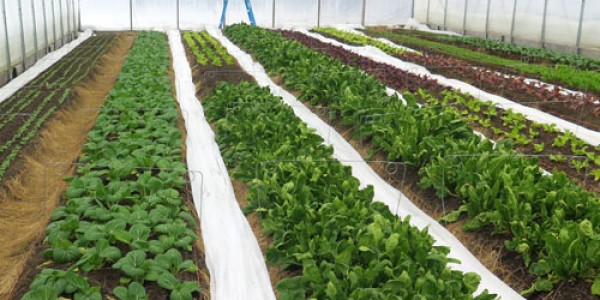Welcome to the No-till Farming Revolution

I definitely know that I love my job when I am more excited than ever for the growing season to begin, my fifth at Gaining Ground. And by “begin” I mean “continue,” as we have been harvesting and distributing fresh produce throughout the winter months.
At the end of last season, we finally decided to go for it. We took the leap to transition the farm into permanent no-till raised beds. “No-till” is the practice of growing crops without disturbing the soil. We discovered this method after constructing our first hoop house late in the winter of 2013.
Before planting in the hoop house in the spring of 2014, we did what any farmer might do. We fired up the rototiller and drove it over to the hoop house to prepare the soil underneath the structure for planting. This turned out to be a poor decision for two reasons. First, all the fumes of the rototiller were trapped inside with us and second, it’s a very tight space in which to try to maneuver a powerful piece of equipment.
We then moved to Plan B and purchased our first broadfork to use instead of the rototiller. It has two handles connected to a steel base welded to five to seven 10-inch tines. The 30-inch wide base is the same width as our raised beds. The user inserts the tines deep into the raised bed and simply pulls back on the handles and repeats every 6 inches while working backward down the bed. The broadfork improves aeration and breaks up compaction without disturbing the structure or biology of the soil. After two seasons of only using the broadfork in the hoop house, we have observed dramatic changes in the soil which have directly affected the plants grown in these no-till beds. The weeds are now non-existent in the hoop house because we have eliminated turning up dormant weed seed through tillage.
Another benefit has been the efficiency of replanting or turning the beds over. As fall approaches and the tomatoes start to senesce or deteriorate, we will simply chop down the tomato plants at the base. This leaves the root system in place to exude all its excess stored sugars and starches, which then feed the mycorrhizal (beneficial fungi). Next we can move in with a group of volunteers all armed with broadforks to prepare the bed for re-planting of winter greens that same day.
After observing all the pros of the no-till system in the hoop house I’m left with one question: Why didn’t we take these methods to the whole farm sooner? I have no answer to that question, but know that I am so very excited to continue implementing what we know will be the future of Gaining Ground. Which in short will be less weeding and more harvesting!